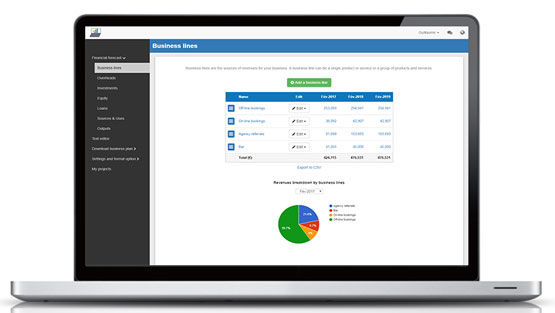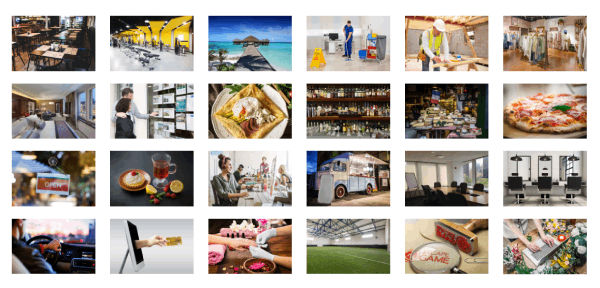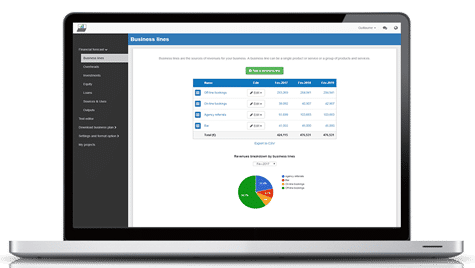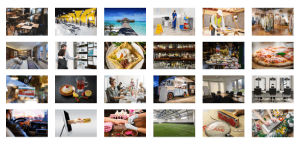How to open a gin bar?
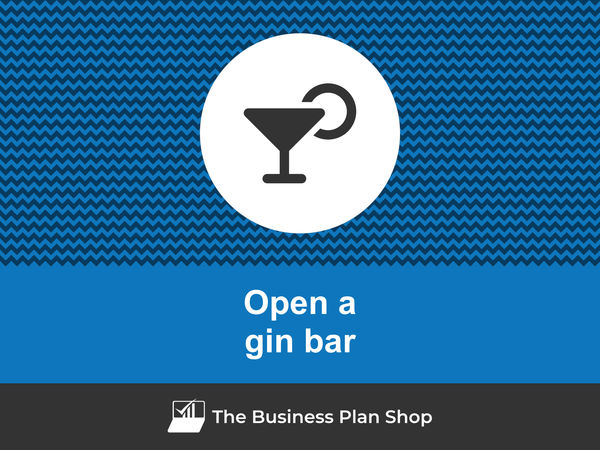
Want to start a gin bar but don't know where to begin? Then you've come to the right place!
Our comprehensive guide covers everything related to opening a gin bar - from choosing the right concept to setting out your marketing plan and financing your business.
You'll also learn how to assess the profitability of your business idea and decide whether or not it can be viable from a financial perspective.
Ready to kickstart your entrepreneurial journey? Let's begin!
Learn how a gin bar works
Before you can start a gin bar, you need to have a solid understanding of how the business works and what are its main revenue streams.
This will give you a glimpse into the profitability potential of your venture, whilst allowing you to decide whether or not it is a good fit for your situation (current skill set, savings and capital available to start the business, and family responsibilities).
It may be that creating a gin bar is an excellent idea, but just not the right one for you.
Before starting their own company, successful entrepreneurs typically:
- Consult with and take advice from experienced gin bar owners
- Acquire hands-on experience by working in an operational gin bar
- Take relevant training courses
Let's explore each option in a bit more detail.
Consulting with and taking advice from experienced gin bar owners
Having "seen it all", established business owners can offer valuable insights and hands-on advice drawn from their own experiences.
This is because, through both successes and failures, they've gained a more informed and practical understanding of what it takes to build and sustain a successful gin bar over the long term.
Acquiring hands-on experience by working in an operational gin bar
If you want to open a gin bar, having industry-specific experience is imperative because it equips you with the knowledge, network, and acumen necessary to navigate challenges and make informed decisions critical to the success of your future business.
You'll also be able to judge whether or not this business idea is suitable for you or if there might be conflicts of interest with your personal life (for example, long working hours could be incompatible with raising young children).
This work experience will also help you to make contacts in the industry and familiarise yourself with customers and their expectations, which will prove invaluable when you set up your gin bar.
Take relevant training courses
Taking a training course is another way of familiarising yourself with the business model of your future activity before you decide to make the jump.
You may choose to complete a training course to obtain a certificate or degree, or just take online courses to acquire practical skills.
Before going any further in setting up your venture
Before you go any further with your plans to open a gin bar, make sure you have a clear vision of what it will take in terms of:
- What skills are needed to run the business successfully (do you have some or all of these skills?)
- What a standard working week looks like (does it suit your personal commitments?)
- What sales potential and long-term growth prospects the gin bar has (compare this with your level of ambition)
- What options you'll have once you decide to retire (or move on and inevitably sell the company)
This analysis of the business model and the constraints of the business should help you to check that your idea of launching a gin bar fits your entrepreneurial profile.
If there is a match, it will then be time to look at assembling the founding team of your business.
Assembling your gin bar's founding team
The next step to opening your gin bar is to think about the ideal founding team, or to decide to go in alone.
Starting and growing a successful business doesn't have to be a solo journey and setting up a gin bar with several co-founders is generally easier. The business benefits from a management team with a wider skillset, decisions are made together, and the financial risk is shared among the partners, making the journey more collaborative and less daunting.
But, running a business with several partners brings its own challenges. Disagreements between co-founders are quite common, and these can pose risks to the business. That's why it's crucial to consider all aspects before starting your own business.
We won't go into too much detail here, as this is a complex topic that deserves its own guide, but we do recommend that you ask yourself the following questions:
- What is the ideal number of co-founders for this venture?
- Are you on the same wavelength as your potential partners in terms of vision and ambition?
- How will you deal with potential failure?
Let's look at each of these questions in more detail.
What is the ideal number of co-founders for this venture?
To answer this question you will need to consider the following:
- What skills do you need to run the business? Are you lacking any?
- How much startup capital do you need? How much do you have?
- How are key decisions going to be made? - It is usually advisable to have an odd number of partners (or a majority shareholder) to help break the tie.
Put simply, your co-founders contribute skills, capital, or both. Increasing the number of partners becomes advantageous when there is a deficiency in either of these resources.
Are you on the same wavelength as your potential partners in terms of vision and ambition?
Your business partners should share the same short and long-term vision, be it business expansion or social responsibility, to avoid future frustrations and simplify decision-making. Different views are natural, but alignment is ideal.
In any case, you should think of having an exit mechanism in place in case one of the partners wants to move on.
How will you deal with potential failure?
We wish you nothing but success when starting up and growing your gin bar, but it's always wise to have a backup in case things don't go as planned.
How you deal with a potential failure can vary significantly based on the relationship you have with your business partner (close friend, spouse, ex-colleague, etc.) and the personal circumstances of each of you.
For instance, starting a business with your spouse might seem appealing, but if it doesn't succeed, you risk losing 100% of the household income at once, which could be stressful.
Similarly, going into a partnership with a friend can put pressure on the friendship in the event of failure or when you need to make difficult decisions.
There is no wrong answer, but it is essential to carefully evaluate your options before starting up to ensure you're well-prepared for any potential outcomes.
Is there room for another gin bar on the market?
The next step in starting a gin bar is to undertake market research. Now, let's delve into what this entails.
The objectives of market research
The goal here is straightforward: evaluate the demand for your business and determine if there's an opportunity to be seized.
One of the key points of your market analysis will be to ensure that the market is not saturated by competing offers.
The market research to open your gin bar will also help you to define a concept and market positioning likely to appeal to your target clientele.
Finally, your analysis will provide you with the data you need to assess the revenue potential of your future business.
Let's take a look at how to carry out your market research.
Evaluating key trends in the sector
Market research for a gin bar usually begins with an analysis of the sector in order to develop a solid understanding of the its key players, and recent trends.
Assessing the demand
After the sector analysis comes the demand analysis. Demand for a gin bar refers to customers likely to consume the products and services offered by your company or its competitors.
Looking at the demand will enable you to gain insights into the desires and needs expressed by your future customers and their observed purchasing habits.
To be relevant, your demand analysis must be targeted to the geographic area(s) served by your company.
Your demand analysis should highlight the following points:
- Who buys the type of products and services you sell?
- How many potential customers are there in the geographical area(s) targeted by your company?
- What are their needs and expectations?
- What are their purchasing habits?
- How much do they spend on average?
- What are the main customer segments and their characteristics?
- How to communicate and promote the company's offer to reach each segment?
Analyzing demand helps pinpoint customer segments your gin bar could target and determines the products or services that will meet their expectations.
Assessing the supply
Once you have a clear vision of who your potential customers are and what they want, the next step is to look at your competitors.
Amongst other things, you’ll need to ask yourself:
- What brands are competing directly/indirectly against your gin bar?
- How many competitors are there in the market?
- Where are they located in relation to your company's location?
- What will be the balance of power between you: are your competitors independent players or franchises?
- What types of services and products do they offer? At what price?
- Are they targeting the same customers as you?
- How do they promote themselves?
- Which concepts seem to appeal most to customers?
- Which competitors seem to be doing best?
The aim of your competitive analysis will be to identify who is likely to overshadow you, and to find a way to differentiate yourself (more on this see below).
Regulations
Market research is also an opportunity to look at the regulations and conditions required to do business.
Ask yourself the following questions:
- Do you need a special degree to open a gin bar?
- Are there necessary licences or permits?
- What are the main laws applicable to your future business?
At this stage, your analysis of the regulations should be carried out at a high level, to familiarize yourself with any rules and procedures, and above all to ensure that you meet the necessary conditions for carrying out the activity before going any further.
You will have the opportunity to come back to the regulation afterwards with your lawyer when your project is at a more advanced stage.
Take stock of the lessons learned from your market analysis
Market research should give you a definitive idea of your business idea's chances of commercial success.
Ideally, the conclusion is that there is a market opportunity because one or more customer segments are currently underserved by the competition.
On the other hand, the conclusion may be that the market is already taken. In this case, don't panic: the first piece of good news is that you're not going to spend several years working hard on a project that has no chance of succeeding. The second is that there's no shortage of ideas out there: at The Business Plan Shop, we've identified over 1,300 business start-up ideas, so you're bound to find something that will work.
Choose the right concept and position your gin bar on the market
The next step to start a gin bar is to choose the company's market positioning.
Market positioning refers to the place your product and service offering occupies in customers' minds and how it differs from how competitors are perceived. Being perceived as a high-end solution, for example.
To do this, you need to take the following considerations into account:
- How can you make your business stand out from your competitors?
- Can you consider joining a franchise as a way to lower the risks involved?
- Is it better to start a new gin bar or acquire one that is already up and running?
- How to make sure your concept meets customer needs?
Let's look at each of these in a little more detail.
How can you make your business stand out from your competitors?
When you decide to start your own gin bar, you're facing an upward challenge because your competitors are already ahead. They have a good reputation, loyal customers, and a strong team, while you're just getting started.
Opening a gin bar offering exactly the same thing as your competitors is risky and potentially doomed to fail: why would customers take the risk of choosing a newcomer rather than a company with a proven track record?
This is why it is advisable to avoid direct confrontation by adopting a differentiated market positioning wherever possible: in other words, by offering something different or complementary to what is available on the market.
To find a market positioning that has every chance of success, you need to ask yourself the following questions:
- Can you negate direct competition by serving a customer profile that is currently poorly addressed by your competitors?
- Can your business provide something different or complementary to what is already available on the market?
- Why will customers choose your gin bar over the competition?
- How will your competitors react to your entry into their market?
- Is the market sufficiently large and fragmented (i.e. not dominated by a few large chains) to allow you to set up an independent business, or is it better to consider another avenue (see below)?
Can you consider joining a franchise as a way to lower the risks involved?
A good way of getting a market positioning that is guaranteed to seduce customers is to join a group with a proven concept.
Admittedly, joining a franchise is not necessarily as exciting as opening a gin bar with a clean slate, everything to invent and total freedom to do so, but it is a proven way of reducing the risk of entering the market.
By joining a franchise, you will benefit from a concept that is successful with customers, the brand recognition of a large network, and operational support with regard to supplier relations, processes and operating standards, etc.
In return, you will have to pay an entry fee and an annual royalty (on your company's sales).
Joining a franchise is a trade-off where you need additional capital and get less freedom in exchange for a lot less risk. It's not for everyone, and it's not possible everywhere (franchise opportunities vary from region to region), but it is nevertheless an option you should explore.
Is it better to start a new gin bar or acquire one that is already up and running?
Another way to benefit from a proven concept and reduce the risk of your project is to take over a gin bar.
Buying a gin bar allows you to get a team, a customer base, and above all to preserve the balance on the market by avoiding creating a new player. For these reasons, taking over a business is a lot less risky than creating one from scratch.
Taking over a business also gives you greater freedom than franchising, because you have the freedom to change the positioning and operations of the business as you see fit.
However, as you can imagine, the cost of taking over a business is higher than that of opening a gin bar because you will have to finance the purchase.
How to make sure your concept meets customer needs?
Once you have decided on your concept and the market positioning of your future gin bar, you will need to check that it meets the needs, expectations and desires of your future customers.
To do this, you need to present it to some of your target customers to gather their impressions.
Explore the ideal location to start your gin bar
The next stage in our guide on how to start a gin bar: choosing where to set up shop.
Setting up your business in the right location will have a direct impact on your chances of success, so it's a good idea to think things through before you launch.
To help you decide where to set up your business, we recommend considering the following factors:
- Visibility and foot traffic: A gin bar relies heavily on attracting customers, so being in a visible and high foot traffic area is crucial for success.
- Parking space, road and public transport accessibility: Customers who are likely to visit a gin bar will want convenient access to parking and public transportation options.
- Proximity to target customers: It is important to be located near the target demographic for a gin bar, which could include young professionals or tourists.
- Premises layout: The layout and design of the space should be considered carefully to create an inviting and comfortable atmosphere for customers.
These criteria will need to be refined according to the specific features of your project.
After weighing the factors mentioned earlier, it's crucial to focus on your startup's budget. Look for a location that suits your business needs while being affordable, especially in the short term.
One of the issues that will also come up is the long-term future of your location, particularly if you opt to rent your premises rather than buy. In this case, you will need to consider the conditions for renewing the lease (duration, rent increases, etc.).
Lease agreements vary widely from country to country, so make sure you check the terms applicable to your situation and have your lawyer review your lease before you sign.
Choosing your gin bar's legal form
The next step to open a gin bar is to choose the legal form of your business.
The legal form of a business simply means the legal structure it operates under. This structure outlines how the business is set up and defines its legal obligations and responsibilities.
Why is your gin bar's legal form important?
Choosing the legal form for your gin bar is an important decision because this will affect your tax obligations, your personal exposure to risk, how decisions are made within the business, the sources of financing available to you, and the amount of paperwork and legal formalities, amongst other things.
The way you set up your business legally will impact your taxes and social contributions, both at a personal level (how much your income is taxed) and at the business level (how much the business's profits are taxed).
Your personal exposure to risk as a business owner also varies based on the legal form of your business. Certain legal forms have a legal personality (also called corporate personality), which means that the business obtains a legal entity which is separate from the owners and the people running it. To put it simply, if something goes wrong with a customer or competitor, for example, with a corporate personality the business gets sued, whereas without it is the entrepreneur personally.
Similarly, some legal forms benefit from limited liability. With a limited liability the maximum you can lose if the business fails is what you invested. Your personal assets are not at risk. However, not all structures protect you in such a way, some structures may expose your personal assets (for example, your creditors might try to go after your house if the business incurs debts and then goes under without being able to repay what it owed).
How decisions are made within the business is also influenced by the legal form of your gin bar, and so is the amount of paperwork and legal formalities: do you need to hold general assemblies, to produce annual accounts, to get the accounts audited, etc.
The legal form also influences what sources of financing are available to you. Raising capital from investors requires having a company set up, and they will expect limited liability and corporate personality.
What are the most common legal structures?
It's important to note that the actual names of legal structures for businesses vary from country to country.
But they usually fall within two main types of structures:
- Individual businesses
- Companies
Individual businesses
Individual businesses, such as sole traders or sole proprietorships, are legal structures with basic administrative requirements.
They primarily serve self-employed individuals and freelancers rather than businesses with employees.
The main downside of being a sole trader is that there's usually no legal separation between the business and the person running it. Everything the person owns personally is tied up with the business, which can be risky.
This means that if there are problems or the business goes bankrupt, the entrepreneur's personal assets could be taken by creditors. So, there's a risk of personal liability in case of disputes or financial issues.
It is also not possible to raise equity from investors with these structures as there is no share capital.
Despite the downsides, being a sole proprietorship has some advantages. There is usually very little paperwork to get started, simpler tax calculations and accounting formalities.
Companies
Companies are all rounders which can be set up by one or more individuals, working on their own or with many employees.
They are recognized as a distinct entity with their own legal personality, and the liability is usually limited to the amount invested by the owners (co-founders and investors). This means that you cannot lose more than you have invested in the business.
This separation ensures that in legal disputes or bankruptcy, the company bears primary responsibility, protecting the personal assets of the founder(s) and potential investor(s).
How should I choose my gin bar's legal structure?
Deciding on the legal structure is usually quite straightforward once you know how many co-founders you'll have, whether you'll have employees, and the expected revenues for the business.
A good business idea will be viable whatever the legal form you choose. How businesses are taxed changes every year, therefore one cannot rely on specific tax benefits tied to a particular structure when deciding to go into business.
One easy way to proceed is to take note of the legal structures used by your top five competitors, and assume you're going with the most commonly chosen option. Once your idea is mature and you're prepared to formally register the business, you can validate this assumption with a lawyer and an accountant.
Can I switch my gin bar's legal structure if I get it wrong?
You can switch your legal setup later on, even if it involves selling the old one to a new entity in some cases. However, this comes with extra costs, so it's better to make the right choice from the beginning if you can.
How much money do I need to start a gin bar?
To answer this key question, we first need to look at the resources you'll need to launch your gin bar and keep it running on a daily basis. Let's take a look at what that entails.
Since each venture is distinct, providing an average budget for starting a gin bar is impossible.
We strongly advise careful consideration when reading estimates on the web. It’s best to ask yourself the following questions:
- Is my project similar (location, concept, planned size, etc.)?
- Can I trust where this information is coming from?
- Is the data fresh or stale?
Your thinking behind the investments and human resources required to launch and operate the business will then enable you to cost each item and include them in your financial forecast (which we'll look at later in this guide).
Once complete, the forecast will give you a precise idea of the initial investment required and profitability potential for your business idea.
Startup costs and investments to start a gin bar
Let's start with the investments. To set up a gin bar, initial working capital and investments can include the following items:
- Equipment: This includes all the necessary equipment for running a gin bar, such as a commercial-grade gin still, refrigeration units, glassware, and bar tools.
- Furniture: You will need to furnish your gin bar with tables, chairs, bar stools, and other seating options to create a welcoming and comfortable atmosphere for your customers.
- Décor: The overall look and feel of your gin bar is important in attracting customers. This may include lighting, wall art, signage, and other decorative elements.
- POS System: A point-of-sale system is essential for managing sales, inventory, and customer data. This includes hardware, software, and any necessary licenses or subscriptions.
- Security Systems: To protect your investment, you may want to install security cameras, alarms, and other safety measures to ensure the safety of your staff and customers.
Of course, you will need to adapt this list to your company's specific needs.
Staffing requirements to operate a gin bar
You'll also need to think about the staff required to run the business on a day-to-day basis.
The human resources required will vary according to the size of your company.
Once again, this list is only indicative and will need to be adjusted according to the specifics of your gin bar.
Operating expenses of a gin bar
The final point to consider when analyzing the resources required is the question of operating costs.
Operating expenses for a gin bar may include:
- Staff costs: This includes salaries, wages, and benefits for your bartenders, servers, and other staff members.
- Accountancy fees: You may need to hire an accountant to help you with bookkeeping, tax filings, and other financial matters.
- Insurance costs: It's important to have insurance coverage for your gin bar, including general liability, liquor liability, and property insurance.
- Software licences: You may need to purchase licences for point-of-sale systems, inventory management software, and other programs to help run your gin bar efficiently.
- Banking fees: You'll need to pay fees for processing credit and debit card transactions, as well as for maintaining a business bank account.
- Inventory costs: This includes the cost of purchasing gin, mixers, garnishes, and other ingredients for your drinks.
- Marketing expenses: You may need to budget for advertising, promotions, and other marketing efforts to attract customers to your gin bar.
- Rent: You'll need to pay rent for your bar space, whether it's a standalone building or a space within a larger establishment.
- Utilities: This includes the cost of electricity, water, gas, and other utilities needed to operate your gin bar.
- Liquor license: You'll need to obtain a liquor license to legally serve alcohol at your gin bar, and this may come with an annual fee.
- Cleaning and maintenance: You'll need to budget for cleaning supplies, equipment maintenance, and other costs associated with keeping your bar clean and well-maintained.
- Music licensing: If you plan to play music in your gin bar, you'll need to pay for the appropriate licenses and royalties.
- Training and education: It's important to invest in ongoing training and education for your staff to ensure they have the knowledge and skills to provide excellent service at your gin bar.
- Legal fees: You may need to consult with a lawyer for legal advice or to help you navigate any legal issues that may arise in your gin bar.
- Taxes: You'll need to budget for various taxes, such as income tax, sales tax, and payroll tax, that apply to your gin bar.
Here also, this list will need to be tailored to the specifics of your gin bar but should be a good starting point for your budget.
Creating a sales & marketing plan for your gin bar
The next step to start a gin bar is to think about how you are going to attract and retain customers.
You need to ask yourself the following questions:
- What actions can be leveraged to attract as many customers as possible?
- How will you then retain customers?
- What resources do you need to allocate for each initiative (human and financial)?
- How many sales and what turnover can you expect to generate in return?
How you will attract and retain customers depends on your ambition, the size of your startup and the nature of your exact concept, but you could consider the following initiatives.
Your sales forecast may also be influenced by seasonality related to your business type, such as fluctuations during busy holiday periods, and your competitive environment.
How do I build my gin bar financial forecast?
Let's now look at the financial projections you will need to prepare in order to open a gin bar.
What is a gin bar's financial projection?
Your financial forecast will help you budget your project so that you can evaluate:
- Its expected sales and growth potential
- Its expected profitability, to ensure that the business will be viable
- Its cash generation and financing requirements
Making your financial forecast is the only way to determine the amount of initial financing required to create your gin bar.
There are lots of business ideas out there, but very few of them are viable, and making a financial forecast is the only way to ensure that your project makes economic and financial sense.
Creating a gin bar financial projection is an iterative process, as you'll need to refine your figures as your business idea matures.
You'll start with a first high-level version to decide whether or not to continue working on the project.
Then, as your project takes shape, your forecasts will become increasingly accurate. You'll also need to test different assumptions to ensure that your idea of starting a gin bar holds up even if your trading environment deteriorates (lower sales than expected, difficulties in recruiting, sudden cost increases or equipment failure problems, for example).
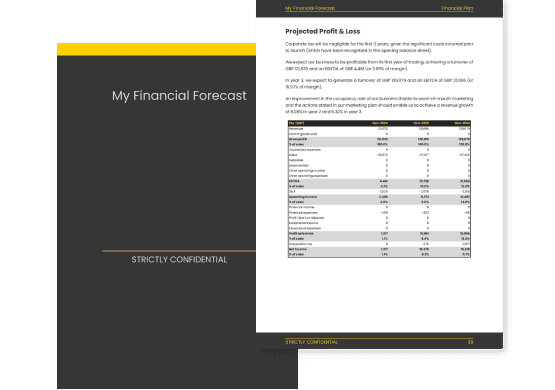
Your financial forecast will be part of your overall business plan, which we'll look at in more detail later. Your financial partners will use your business plan to decide if they want to finance you.
Once you've launched your business, you can compare your actual accounting figures with your forecasts, to analyze where the discrepancies come from, and then update your forecasts to maintain visibility over your future cash flows.
Financial forecasts are, therefore, a financial management tool that will be with you throughout the life of your company.
What does a financial forecast look like?
Once ready, your gin bar forecast will be presented using the financial tables below.
The forecasted profit & loss statement
The profit & loss forecast gives you a clear picture of your business’ expected growth over the first three to five years, and whether it’s likely to be profitable or not.
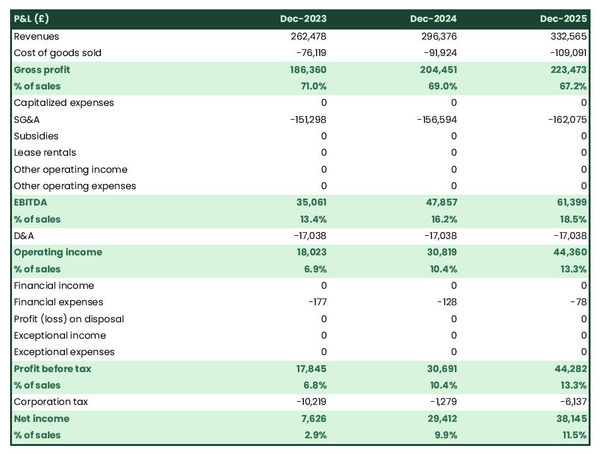
The projected balance sheet
Your gin bar's forecasted balance sheet enables you to assess your financial structure and working capital requirements.
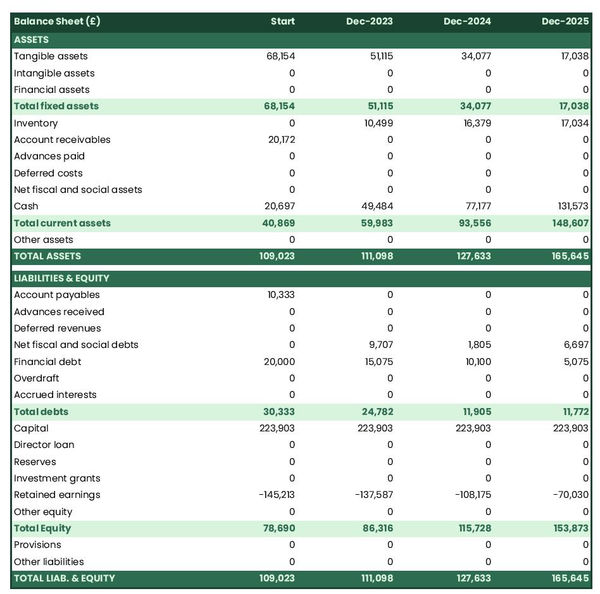
The projected cash flow statement
A projected cash flow statement to start a gin bar is used to show how much cash the business is expected to generate or consume over the first three years.
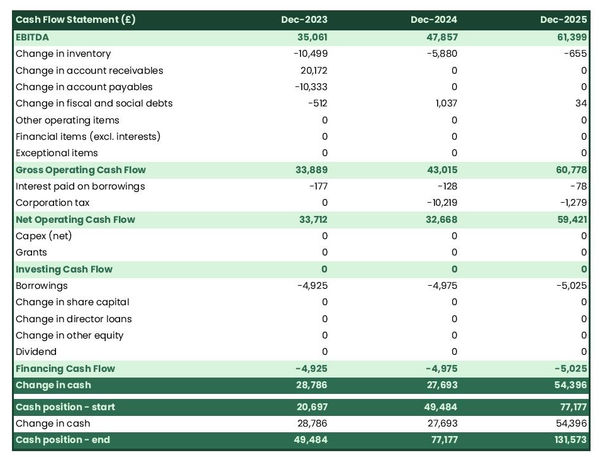
Which solution should you use to make a financial forecast for your gin bar?
The easiest and safest way to create your gin bar forecasts is to use an online financial forecasting software, like the one we offer at The Business Plan Shop.
There are several advantages to using professional software:
- You can easily create your financial forecast by letting the software take care of the financial calculations for you without errors
- You have access to complete financial forecast templates
- You get a complete financial forecast ready to be sent to your bank or investors
- The software helps you identify and correct any inconsistencies in your figures
- You can create scenarios to stress-test your forecast's main assumptions to stress-test the robustness of your business model
- After you start trading, you can easily track your actual financial performance against your financial forecast, and recalibrate your forecast to maintain visibility on your future cash flows
- You have a friendly support team on standby to assist you when you are stuck
If you are interested in this type of solution, you can try our forecasting software for free by signing up here.
Choose a name and register your gin bar
The next phase in launching your gin bar involves selecting a name for your company.
This stage is trickier than it seems. Finding the name itself is quite fun; the difficulty lies in finding one that is available and being the first to reserve it.
You cannot take a name that is similar to a name already used by a competitor or protected by a registered trademark without inevitably risking legal action.
So you need to find a name that is available, and be able to register it before someone else can.
In addition, you will probably want to use the same name for:
- Your company’s legal name - Example LTD
- Your business trading name - Example
- The trademark - Example ®
- Your company’s domain name - Example.com
The problem is that the procedures for registering these different names are carried out in different places, each with their own deadlines:
- Registering a domain name takes only a few minutes
- Registering a new trademark takes at least 12 weeks (if your application is accepted)
- The time taken to register a new business depends on the country, but it's generally fast
You will therefore be faced with the choice of: either registering everything at once and hoping that your name will be accepted everywhere, or proceeding step by step in order to minimise costs, but taking the risk that someone else will register one of the names you wanted in the meantime.
Our advice is to discuss strategy with your legal counsel (see further down in this guide) and prioritise your domain names and registered trademarks. You'll always have the option of using a trade name that's different from your company's legal name, and that's not a big deal.
To check that the name you want is not already in use, you should consult:
- Your country's business register
- The relevant trademark registers depending on which countries you want to register your trade mark in
- A domain name reservation company such as GoDaddy
- An Internet search engine
In this area too, your legal counsel will be able to help with the research and formalities.
What corporate identity do I want for my gin bar?
The following step to start a gin bar is to define your company's visual identity.
Visual identity is part of the DNA of your gin bar: it makes you recognizable and recognized by your customers, and helps you stand out from the competition. It also helps convey your values, notably through the choice of colors that identify the company.
Creating your business's visual identity yourself is entirely possible: there are several online tools that let you generate color palettes, choose typography and even generate logos.
However, we advise you to delegate this task to a designer or a communications agency for a professional result.
Your corporate identity will include the following elements:
- Your business logo
- Your brand guidelines
- Your business cards
- Design and theme of your website
Logo
Your gin bar's logo serves as a quick identifier for your company. It will be featured on all your communication platforms (website, social networks, business cards, etc.) and official documents (invoices, contracts, etc.).
Beyond its appearance, your logo should be easy to use on any type of support and background (white, black, gray, colored, etc.). Ideally, it should be easy to use in a variety of colors.
Brand guidelines
One of the challenges when starting a gin bar is to ensure a consistent brand image wherever your company is visible.
This is the role of your company's brand guidelines, which defines the typography and colors used by your brand and thus acts as the protector of your brand image.
Typography refers to the fonts used (family and size). For example, Trebuchet in size 22 for your titles and Times New Roman in size 13 for your texts.
The colors chosen to represent your brand should typically be limited to five (or fewer):
- The main colour,
- A secondary colour (the accent),
- A dark background colour (blue or black),
- A grey background colour (to vary from white),
- Possibly another secondary colour.
Business cards
Classic but a must-have, your business cards will be at your side to help you easily communicate your contact details to your founders, customers, suppliers, recruitment candidates, etc.
In essence, they should feature your logo and adhere to the brand guidelines mentioned earlier.
Website theme
Likewise, the theme of your gin bar website will integrate your logo and follow the brand guidelines we talked about earlier.
This will also define the look and feel of all your site's graphic elements:
- Buttons
- Menus
- Forms
- Banners
- Etc.
Understanding the legal and regulatory steps involved in opening a gin bar
The next step in opening a gin bar is to take the necessary legal and regulatory steps.
We recommend that you be accompanied by a law firm for all of the steps outlined below.
Registering a trademark and protecting the intellectual property of your gin bar
The first step is to protect your company's intellectual property.
As mentioned earlier in this guide, you have the option to register a trademark. Your lawyer can assist you with a thorough search to ensure your chosen trademark is unique and doesn't conflict with existing ones and help select the classes (economic activities) and jurisdictions in which to register your trademark.
Your lawyer will also be able to advise you on other steps you could take to protect your company's other intellectual property assets.
Drafting the contractual documents for your gin bar
Your gin bar will rely on a set of contracts and legal documents for day-to-day operations.
Once again, we strongly recommend that you have these documents drawn up by a lawyer.
Your exact needs will depend on the country in which you are launching your gin bar and the size of the company you are planning.
However, you may wish to consider the following documents at a minimum:
- Employment contracts
- General terms and conditions of sale
- General terms and conditions of use for your website
- Privacy Policy for your website
- Cookie Policy for your website
- Invoices
- Etc.
Applying for licences and permits and registering for various taxes
The licenses and permits needed for your business will depend on the country where you are establishing it. Your lawyer can guide you on the regulations relevant to your activity.
Similarly, your chartered accountant will be able to help you register for taxes and take the necessary steps to comply with the tax authorities.
Writing a business plan for your gin bar
The next step in opening a gin bar is to draw up your business plan.
What is a gin bar's business plan?
A business plan serves as a comprehensive roadmap outlining the objectives, strategies, and key components of your venture.
There are two essential parts to a business plan:
- A numerical part, the financial forecast we mentioned earlier in this guide, which highlights the amount of initial financing needed to launch the business and its potential profitability over the next 3 to 5 years,
- A written part, which presents in detail the project of creating a gin bar and provides the necessary context to enable the reader of the business plan to judge the relevance and coherence of the figures included in the forecast.
Your business plan helps guide decision-making by showcasing your vision and financial potential in a coherent manner.
Your business plan will also be essential when you're looking for financing, as your financial partners will ask you for it when deciding whether or not to finance your project to open a gin bar. So it's best to produce a professional, reliable, and error-free business plan.
In essence, your business plan is the blueprint to turn your idea into a successful reality.
What tool should you use to create your gin bar business plan?
If you want to write a convincing business plan quickly and efficiently, a good solution is to use an online business plan software for business start-ups like the one we offer at The Business Plan Shop.
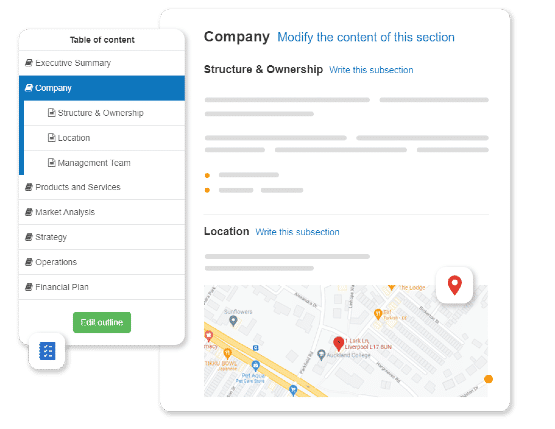
Using The Business Plan Shop to create a business plan for a gin bar has several advantages :
- You can easily create your financial forecast by letting the software take care of the financial calculations for you without errors
- You are guided through the writing process by detailed instructions and examples for each part of the plan
- You can access a library of dozens of complete startup business plan samples and templates for inspiration
- You get a professional business plan, formatted and ready to be sent to your bank or investors
- You can create scenarios to stress test your forecast's main assumptions
- You can easily track your actual financial performance against your financial forecast by importing accounting data
- You can easily update your forecast as time goes by to maintain visibility on future cash flows
- You have a friendly support team on standby to assist you when you are stuck
If you're interested in using our solution, you can try The Business Plan Shop for free by signing up here.
How to raise finance for my gin bar?
Once your business plan has been drafted, you’ll need to think about how you might secure the financing necessary to open your gin bar.
The amount of initial financing required will obviously depend on the size of your gin bar and the country in which you wish to set up.
Businesses have access to two main categories of financing: equity and debt. Let's take a closer look at how they work and what sources are available.
Equity funding
At a high level, the equity of your gin bar will consist of the money that founders and potential investors will invest to launch the company.
Equity is indispensable as it provides the company with a source of long-term (often permanent) financing and demonstrates the founders' conviction in the company's chances of success, since their investments would be lost in the event of bankruptcy.
Equity investors can generate a return on their investment through dividends (which can only be paid out if the company is profitable) or capital gains on the resale of their shares (if the company is attractive enough to attract a buyer).
As you can see, the equity investors' position is extremely risky, since their capital is at risk and can be lost in the event of bankruptcy, and the company must be profitable or resellable before they can hope to generate a return on their investment.
On the other hand, the return on investment that equity investors can expect to generate by investing in a gin bar can be very substantial if the company is successful.
This is why equity investors look for start-up ideas with very high growth or profitability potential, in order to offset their risk with a high potential return on investment.
In technical terms, equity includes:
- Share capital and premiums: which represent the amount invested by the shareholders. This capital is considered permanent as it is non-refundable. In return for their investment, shareholders receive shares that entitle them to information, decision-making power (voting in general assembly), and the potential to receive a portion of any dividends distributed by the company.
- Director loans: these are examples of non-permanent capital advanced to the company by the shareholders. This is a more flexible way of injecting some liquidity into your company than doing so as you can repay director loans at any time.
- Reserves: these represent the share of profits set aside to strengthen the company's equity. Allocating a percentage of your profits to the reserves can be mandatory in certain cases (legal or statutory requirement depending on the legal form of your company). Once allocated in reserves, these profits can no longer be distributed as dividends.
- Investment grants: these represent any non-refundable amounts received by the company to help it invest in long-term assets.
- Other equity: which includes the equity items which don't fit in the other categories. Mostly convertible or derivative instruments. For a small business, it is likely that you won't have any other equity items.
The main sources of equity are as follows:
- Money put into the business from the founders' personal savings.
- Money invested by private individuals, which can include business angels, friends, and family members.
- Funds raised through crowdfunding, which can take the form of either equity or donations (often in exchange for a reward).
- Government support to start-ups, for example, loans on favourable terms to help founders build up their start-up capital.
Debt funding
The other way to finance your gin bar is to borrow. From a financial point of view, the risk/return profile of debt is the opposite of that of equity: lenders' return on investment is guaranteed, but limited.
When it borrows, your company makes a contractual commitment to pay the lenders by interest, and to repay the capital borrowed according to a pre-agreed schedule.
As you can see, the lenders' return on investment is independent of whether or not the company is profitable. In fact, the only risk taken by lenders is the risk of the company going bankrupt.
To avoid this risk, lenders are very cautious, only agreeing to finance when they are convinced that the borrowing company will be able to repay them without problems.
From the point of view of the company and its stakeholders (workforce, customers, suppliers, etc.), debt increases the risk of the venture, since the company is committed to repaying the capital whether or not it is profitable. So there's a certain distrust towards heavily indebted companies.
Companies borrow in two ways:
- Against their assets: this is the most common way of borrowing. The bank finances a percentage of the price of an asset (a vehicle or a building, for example) and takes the asset as collateral. If the company cannot repay, the bank seizes the asset and sells it to limit its losses.
- Against their future cash flows: the bank reviews the company's financial forecast to estimate how much the company can comfortably borrow and repay, and what terms (amount, interest rate, term, etc.) the bank is prepared to offer given the credit risk posed by the company.
When creating a gin bar, the first option is often the only one available, as lenders are often reluctant to lend on the basis of future cash flows to a structure that has no track record.
The type of assets that can be financed using the first method is also limited. Lenders will want to be sure that they can dispose of foreclosed assets if needed, so they need to be assets that have an established second-hand market.
That being said, terms and conditions also depend on the lender: some banks are prepared to finance riskier projects, and not all have the same view of your company's credit risk. It also depends on the collateral you can offer to reduce risk, and on your relationship with the bank.
In terms of possible sources of borrowing, the main sources here are banks and credit institutions.
In some countries, it's also possible to borrow from private investors (directly or via crowdlending platforms) or other companies, but not everywhere.
Takeaways on how to finance a gin bar
Multiple options are available to help you raise the initial financing you need to launch your gin bar.
There are two types of financing available to companies. To open a gin bar, an equity investment will be required and may be supplemented by bank financing.
Launching your gin bar and monitoring progress against your forecast
Once you’ve secured financing, you will finally be ready to launch your gin bar. Congratulations!
Celebrate the launch of your business and acknowledge the hard work that brought you here, but remember, this is where the real work begins.
As you know, 50% of business start-ups do not pass the five-year mark. Your priority will be to do everything to secure your business's future.
To do this, it is key to keep an eye on your business plan to ensure that you are on track to achieve your goals.
No one can predict the future with certainty, so it’s likely that your gin bar's financial performance will differ from what you predicted in your forecast.
This is why it is recommended to make several forecasts:
- A base case (most likely)
- An optimistic scenario
- And a pessimistic scenario to test the robustness of your financial model
If you follow this approach, your numbers will hopefully be better than your optimistic case and you can consider accelerating your expansion plans. That’s what we wish you anyway!
If, unfortunately, your figures are below your base case (or worse than your pessimistic case), you will need to quickly put in place corrective actions, or consider stopping the activity.
The key, in terms of decision-making, is to regularly compare your real accounting data to your gin bar's forecast to:
- Measure the discrepancies and promptly identify where the variances with your base case come from
- Adjust your financial forecast as the year progresses to maintain visibility on future cash flow and cash position
There is nothing worse than waiting for your accountant to prepare your year-end accounts, which can take several months after the end of your financial year (up to nine months in the UK for example), to realise that the performance over the past year was well below the your base case and that your gin bar will not have enough cash to keep running over the next twelve months.
This is why using a financial forecasting solution that integrates with accounting software and offers actuals vs. forecast tracking out of the box, like the financial dashboards we offer at The Business Plan Shop, greatly facilitates the task and significantly reduces the risk associated with starting a business.
Key takeaways
- There are 15 key steps to opening a gin bar.
- Your financial forecast will enable you to accurately assess your initial financing requirements and the potential profitability of your project.
- Your business plan will give your financial partners the context they need to be able to judge the consistency and relevance of your forecast before deciding whether or not to finance the creation of your gin bar.
- Post-launch, it's essential to have an up-to-date forecast to maintain visibility of your business's future cash flows.
- Using a financial planning and analysis platform that integrates forecasts, business plans and actual performance monitoring, such as The Business Plan Shop, makes the process easier and reduces the risks involved in starting a business.
We hope this guide has helped you understand how to open a gin bar. Please don't hesitate to contact us if you have any questions or want to share your experience as an entrepreneur.
Also on The Business Plan Shop
Know someone who wants to start a gin bar? Share this guide with them!
